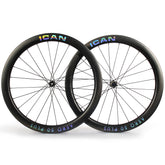Buying guide for fat bike wheels
Over the last year, fat bike wheels haven't changed much, but the trend shows that the width of the rim is increasing. Due to the epidemic, the production of fat bike wheels has also stagnated.
When you're looking for wheels for your fat bike, you'll find a plethora of choices. If this is your first time searching, it can be confusing. There are important details you need to know before getting started that will make finding your new fat bike wheels easier.
- What width do the hubs need?
- What tire clearance does your frame offer?
- Material of the rims for fat bike wheels
- Number of spokes
1.Choose a suitable fat bike hub width
Fat bike wheels have gone through various iterations of hub width.
Initially there were hubs with an offset width of 135mm, the standard for traditional mountain bikes. As interest in fat bikes grew, manufacturers began producing specialized fat bike hubs and frames to support these new hub standards.
The biggest change was the transition to thru axles. Thru axles provide better support for the weight of large wheels. In the past, quick-release axles that held fat bike wheels in place could break. The transition to thru-axles has meant that most fat bikes now use a 15mm x 150mm front axle. However, there are some notable exceptions, such as the Surly Pugsley, which uses a 135mm offset front axle. Therefore, it is important that you check what you have.

2.Know the clearances of your fat bike frame
How much clearance your fat bike frame has depends on how wide a rim you need. And fat tires of different widths must fit tires of different sizes. The clearance of the ICAN fat bike frame is usually 15x197 mm. Below you will find the fat tire size that matches the width of the fat rim
- Rim width from 70mm to 100mm for 3.8-4.2 inch tires

3.Fat bike rims material
The material of the fat bike rims is also an important factor when you are considering purchasing a fat bike wheel. A good rim can help you ride more smoothly and make your fat bike wheels last longer.
Fat bike rims are usually made of either aluminum or carbon fiber. For rims up to 100 mm, a lot of material is required to make a rim. Many aluminum rims then come with cutouts to save weight. One problem with cutouts is that they can make setting up tubeless tires more complicated.
You might think you'll stick with tubes and not worry about tubeless. However, this brings with it a number of other problems. At the low pressures you need to use on a fat bike, you'll likely crush hoses. Changing a tube and inflating a tire on a fat bike is no fun.
However, there is now a solution – carbon fiber rims. These rims are lighter and stronger than the majority of aluminum rims. They also have no cutouts, making taping for tubeless tire setup easier. The lighter weight is excellent, and the easy setup of tubeless tires is even better.
4.Number of spokes on the fat bike wheelset
Spokes are an important part of wheelsets that affect the performance of the entire wheelset.
In general, lighter mountain bike wheels typically have 24-28 spokes per wheel, more robust off-road or all-mountain wheels may use 28 spokes, and the sturdiest wheel systems typically use 32 spokes. These numbers aren't set in stone, but in general, more spokes mean more stability.
So when you buy fat bike wheelsets, you need to know the number of spokes, i.e. the number of holes. The more spokes, the more stable the wheelsets are.
The spokes also determine the feel of the wheel. Heavier spokes make the wheel harder but stronger, while lighter spokes do the opposite. For example, Sapim CX-Ray is a good spoke product due to its strength to weight ratio and is often used in our wheel construction. Sapim Force spokes are stronger and more robust and are used in MTB and gravity oriented wheel construction.
What are fat bike wheels for?
Fat bike wheels are very suitable for riding in snowy environments and are designed for riding on rougher surfaces. No matter it is sand or rocky landscapes, the fat bike wheels can work well.
Are fat bikes suitable for heavy riders?
Due to their wider tires and good load capacity, fat bikes are very suitable for overweight cyclists. Typically, the tires of fat bike wheels are up to 90mm wide, which can transmit most of the pressure to avoid inconvenience.
Conclusion
Now you can avoid the mistakes of buying the wrong hub diameter for your fat bike and you also have a quick and easy guide to ensure you get the correct rim width for your tires. The only thing left to do now is figure out whether you can afford aluminum or carbon fiber rims. Opting for carbon fiber will be lighter, easier for tubeless installation and give you a better riding experience on the trail. Therefore, I would recommend going with carbon fiber.





